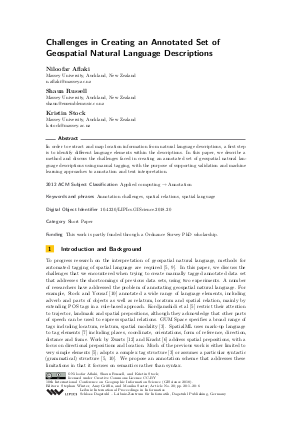Challenges in Creating an Annotated Set of Geospatial Natural Language Descriptions (Short Paper)
Authors Niloofar Aflaki, Shaun Russell, Kristin Stock
-
Part of:
Volume:
10th International Conference on Geographic Information Science (GIScience 2018)
Part of: Series: Leibniz International Proceedings in Informatics (LIPIcs)
Part of: Conference: International Conference on Geographic Information Science (GIScience) - License:
 Creative Commons Attribution 3.0 Unported license
Creative Commons Attribution 3.0 Unported license
- Publication Date: 2018-08-02
File

PDF
LIPIcs.GISCIENCE.2018.20.pdf
- Filesize: 367 kB
- 6 pages
Document Identifiers
Subject Classification
ACM Subject Classification
- Applied computing → Annotation
Keywords
- Annotation challenges
- spatial relations
- spatial language
Metrics
- Access Statistics
-
Total Accesses (updated on a weekly basis)
0Document
0Metadata
Abstract
In order to extract and map location information from natural language descriptions, a first step is to identify different language elements within the descriptions. In this paper, we describe a method and discuss the challenges faced in creating an annotated set of geospatial natural language descriptions using manual tagging, with the purpose of supporting validation and machine learning approaches to annotation and text interpretation.
Cite As Get BibTex
Niloofar Aflaki, Shaun Russell, and Kristin Stock. Challenges in Creating an Annotated Set of Geospatial Natural Language Descriptions (Short Paper). In 10th International Conference on Geographic Information Science (GIScience 2018). Leibniz International Proceedings in Informatics (LIPIcs), Volume 114, pp. 20:1-20:6, Schloss Dagstuhl – Leibniz-Zentrum für Informatik (2018)
https://doi.org/10.4230/LIPIcs.GISCIENCE.2018.20
BibTex
@InProceedings{aflaki_et_al:LIPIcs.GISCIENCE.2018.20,
author = {Aflaki, Niloofar and Russell, Shaun and Stock, Kristin},
title = {{Challenges in Creating an Annotated Set of Geospatial Natural Language Descriptions}},
booktitle = {10th International Conference on Geographic Information Science (GIScience 2018)},
pages = {20:1--20:6},
series = {Leibniz International Proceedings in Informatics (LIPIcs)},
ISBN = {978-3-95977-083-5},
ISSN = {1868-8969},
year = {2018},
volume = {114},
editor = {Winter, Stephan and Griffin, Amy and Sester, Monika},
publisher = {Schloss Dagstuhl -- Leibniz-Zentrum f{\"u}r Informatik},
address = {Dagstuhl, Germany},
URL = {https://drops.dagstuhl.de/entities/document/10.4230/LIPIcs.GISCIENCE.2018.20},
URN = {urn:nbn:de:0030-drops-93482},
doi = {10.4230/LIPIcs.GISCIENCE.2018.20},
annote = {Keywords: Annotation challenges, spatial relations, spatial language}
}
Author Details
Funding
This work is partly funded through a Ordnance Survey PhD scholarship.
References
-
Kenny R Coventry and Simon C Garrod. Saying, seeing and acting: The psychological semantics of spatial prepositions. Psychology Press, 2004.

-
Torsten Hahmann and Michael Gruninger. A naive theory of dimension for qualitative spatial relations. In AAAI Spring Symposium: Logical Formalizations of Commonsense Reasoning, 2011.

-
R Ross J Bateman J Hois, T Tenbrink, R Ross, and J Bateman. Gum-space. Technical report, Technical report, Universität Bremen SFB/TR8 Spatial Cognition, 2009.

-
John D Kelleher and Fintan J Costello. Applying computational models of spatial prepositions to visually situated dialog. Computational Linguistics, 35(2):271-306, 2009.

-
Parisa Kordjamshidi, Martijn Van Otterlo, and Marie-Francine Moens. Spatial role labeling: Towards extraction of spatial relations from natural language. ACM Transactions on Speech and Language Processing (TSLP), 8(3):4, 2011.

-
Marcus Kracht. The fine structure of spatial expressions. Syntax and semantics of spatial P, pages 35-62, 2008.

-
Inderjeet Mani, Christy Doran, Dave Harris, Janet Hitzeman, Rob Quimby, Justin Richer, Ben Wellner, Scott Mardis, and Seamus Clancy. Spatialml: annotation scheme, resources, and evaluation. Language Resources and Evaluation, 44(3):263-280, 2010.

-
Kristin Stock, Didier Leibovici, Luciene Delazari, and Roberto Santos. Discovering order in chaos: using a heuristic ontology to derive spatio-temporal sequences for cadastral data. Spatial Cognition &Computation, 15(2):115-141, 2015.

-
Kristin Stock, Robert C Pasley, Zoe Gardner, Paul Brindley, Jeremy Morley, and Claudia Cialone. Creating a corpus of geospatial natural language. In International Conference on Spatial Information Theory, pages 279-298. Springer, 2013.

-
Kristin Stock and Javid Yousaf. Context-aware automated interpretation of elaborate natural language descriptions of location through learning from empirical data. International Journal of Geographical Information Science, pages 1-30, 2018.

-
Leonard Talmy. Toward a cognitive semantics, volume 2. MIT press, 2000.

-
Joost Zwarts. Prepositional aspect and the algebra of paths. Linguistics and Philosophy, 28(6):739-779, 2005.

